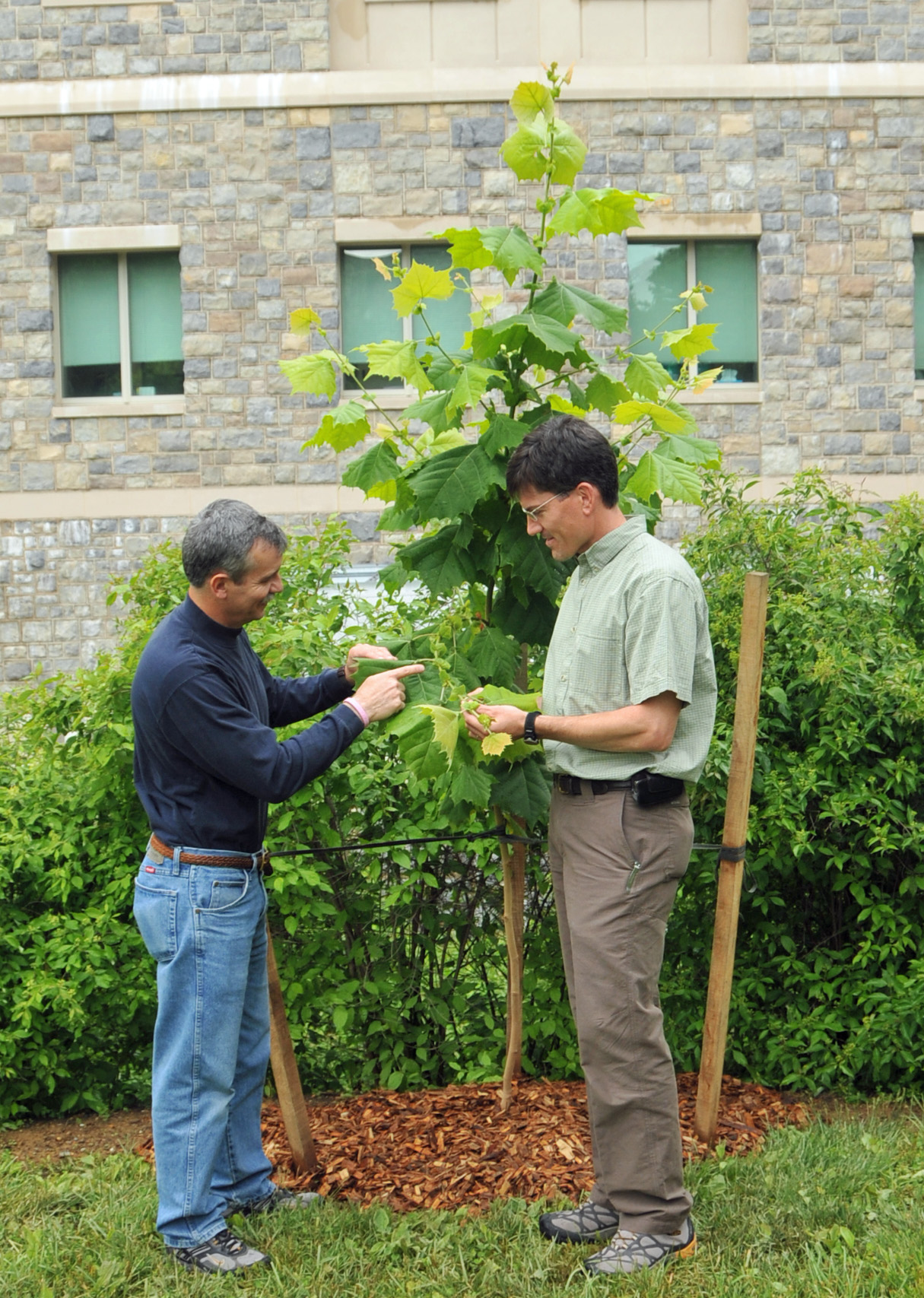Virginia Tech's sycamore is still standing by way of its clone, and the DNA is in it

Thanks to the efforts of two forestry professors, Virginia Tech’s sycamore tree will once again grace Henderson Lawn, which borders the town of Blacksburg, this time by way of its progeny with the same DNA.
On Monday, April 22, at 11:30 a.m., Virginia Tech President Charles W. Steger will preside over a town-gown tree planting celebration with Blacksburg Mayor Ron Rordam on Henderson Lawn near where the original sycamore once stood. The 10-foot tree to be planted was rooted from a cutting taken shortly before the dying historic tree was removed for safety reasons in the summer of 2010.
The celebration, in honor of Earth Day on April 22 and Arbor Day on April 26, is open to the campus, the citizens of Blacksburg, and the public at large, and will go on rain or shine near the corner of Blacksburg’s College Avenue and North Main Street, across from the Lyric Theater.
“The cloning and replanting of the sycamore is a historic milestone in so many ways,” said Rordam. “The strong roots of this tree are a symbol for the strength and perseverance of our community and a true demonstration of how the town and the university can grow together.”
“For years to come, our citizens will be able to stroll along the College Avenue Promenade to Henderson Lawn and create their own memories underneath this great connection to the past,” he continued.
The stately old sycamore, which dated to around 1870, not only tied the town of Blacksburg and Virginia Tech together but was a source of personal connection for many. It served as a site to meet, to sit and relax, and, on a number of occasions, even to propose marriage. Generations of alumni and townspeople have countless memories of the legacy tree that stood so prominently for well over a hundred years.
The sycamore clone being planted is one of only two that miraculously survived from 300 small cuttings taken from the mother tree. “Unfortunately, we just were not very good at getting the cuttings to root,” explained John Seiler, Alumni Distinguished Professor and the Honorable and Mrs. Shelton H. Short Jr. Professor of Forestry in the College of Natural Resources and Environment.
“It was likely the wrong time of year, but we had to try since the tree’s removal was imminent,” he continued. “The only other cutting that survived was planted last May outside the College of Natural Resources and Environment building, which has a tradition of planting a tree honoring each graduating class.”
In a casual conversation with fellow members of the university’s Arboretum Committee in 2010, Seiler lamented the fact that the historic sycamore had to be removed. The idea occurred to them that perhaps they could try cloning the tree. And so they did.
Seiler grew the tree in a campus greenhouse, and then Eric Wiseman, associate professor of urban forestry and arboriculture in the College of Natural Resources and Environment, took over and planted it at the campus Urban Horticulture Center operated by the College of Agriculture and Life Sciences.
“Over time this identical twin will look just like its mother tree, which succumbed to what became a poor growing environment, root damage from underground utility work in the 1980s, fungal disease, and old age,” Wiseman explained.
“The Town of Blacksburg and Virginia Tech have worked closely on the design of the College Avenue project that converts the street into a pedestrian-friendly promenade,” said Matthew Gart, landscape architect for the Office of University Planning. “When we found out about the successful cloning of the tree, we immediately spoke to the town and its project designer about placing the tree within the Henderson Lawn landscape design. It’s been a great cooperative effort to make this happen.”
Because Earth Day, sustainability, and planting trees are inter-related, town-gown officials thought that planting the sycamore clone was an ideal way to recognize the 43rd anniversary of Earth Day on April 22. “This event also marks a special day for Virginia Tech because on April 22, 2009, our University Council voted to recommend that the board of visitors approve the campus Climate Action Commitment Resolution and accompanying Sustainability Plan, which the board later did,” said Denny Cochrane, Virginia Tech’s sustainability program manager.
“Virginia Tech was awarded Tree Campus USA status by the National Arbor Day Foundation in 2008, the inaugural year of the program, and we have received annual re-certification ever since,” Cochrane noted. “Tree planting directly supports the goals of our sustainability program, adds to the beautification of our campus landscape, and is a major component of our student-led Earth Week program each year.”
“A world without trees would be a vastly different place,” added Paul Winistorfer, dean of the College of Natural Resources and Environment. “Trees hold enormous emotional attachments for people of all ages. They are not just valued for their utility.”
“Here in the Appalachian Mountains, we enjoy an incredible diversity of 850 species,” Winistorfer continued, “so this event marks a significant occasion to perpetuate the memory of a tree that was very special to many people over the ages.”
Dedicated to its motto, Ut Prosim (That I May Serve), Virginia Tech takes a hands-on, engaging approach to education, preparing scholars to be leaders in their fields and communities. As the commonwealth’s most comprehensive university and its leading research institution, Virginia Tech offers 240 undergraduate and graduate degree programs to more than 31,000 students and manages a research portfolio of $513 million. The university fulfills its land-grant mission of transforming knowledge to practice through technological leadership and by fueling economic growth and job creation locally, regionally, and across Virginia.





